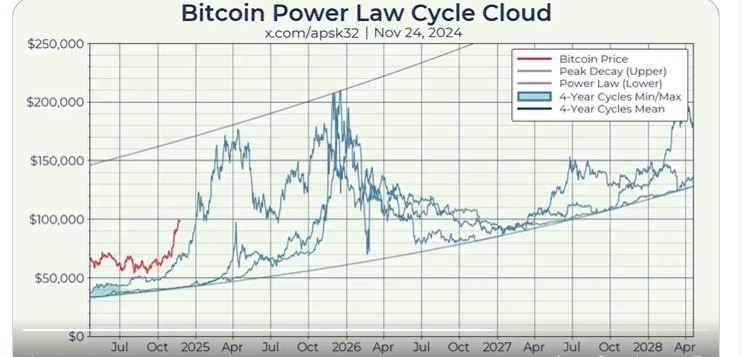Analyst Apsk has weighed in on the timeline for Bitcoin to attain a $150K market top consistent with the previous cycle.
The Bitcoin market has turned bearish again after an unsuccessful attempt to break the $100K price level. Just yesterday, Bitcoin was priced at $98,935, but it has dropped by 7.5% at press time to $91,500.
With this bearish performance sparking concerns, analysts now reassure market participants that Bitcoin is still far from its cycle top. In a post today, Apsk, an engineer and Bitcoin analyst, revisited patterns from Bitcoin’s past cycles, suggesting that the current cycle is still in its early stages.
Apsk pointed out that Bitcoin’s price history has been marked by cyclical peaks occurring roughly every four years, with the last three surging in November or December. The previous cycle highs were:
- 10 Nov 2021: $69,000
- 17 Dec 2017: $19,891
- 29 Nov 2013: $1,242
Based on this historical pattern, Apsk expects the next cycle peak to occur in November-December 2025. Essentially, while some may be concerned about the recent price dip, Apsk’s analysis highlights that Bitcoin is not near its cycle top and that the long-term trajectory remains intact.
Bitcoin Potential Peak for This Cycle
The analyst also highlighted Bitcoin’s adherence to a “power curve” that has provided consistent support for its price over the past 15 years. This curve represents what Apsk believes to be the intrinsic value of the Bitcoin network.
As each cycle progresses, Bitcoin’s price rises above this support line but by progressively smaller percentages. The trend suggests that while Bitcoin will likely continue to rise, the magnitude of its future price explosions may not match the dramatic increases of previous cycles.
For instance, after Bitcoin peaked in 2013 at $1,242, it later dropped to $171 by January 2015, presenting the cycle’s bottom at the time. It was from this point that Bitcoin soared to the $20K peak of the 2017 cycle. This represented an astonishing 11,532% growth during the post-halving bull run of the 2016/2017 cycle.
However, in the 2020/2021 post-halving run, Bitcoin did not mirror the 115X surge of the previous cycle. Instead, it rose by 2,062% from around $3K to $69K. Essentially, Apsk’s analysis suggests Bitcoin’s peak could reach $150K in this cycle, which would represent a 900% rise from the $15K bottom.

Could This Cycle Be Different?
While acknowledging the market’s potential for explosive growth, Apsk noted some key differences in the current cycle that could impact future price movements.
These include the approval of Bitcoin exchange-traded funds (ETFs), a more favorable political environment, and institutional players like Michael Saylor, Chairman of MicroStrategy, who continues to leverage debt to acquire more Bitcoin.
Apsk suggests that these factors might fuel further upward momentum in the short term, but he cautioned that they could also lead to volatility or corrections.
Analyst Apsk has weighed in on the timeline for Bitcoin to attain a $150K market top consistent with the previous cycle.
The Bitcoin market has turned bearish again after an unsuccessful attempt to break the $100K price level. Just yesterday, Bitcoin was priced at $98,935, but it has dropped by 7.5% at press time to $91,500.
With this bearish performance sparking concerns, analysts now reassure market participants that Bitcoin is still far from its cycle top. In a post today, Apsk, an engineer and Bitcoin analyst, revisited patterns from Bitcoin’s past cycles, suggesting that the current cycle is still in its early stages.
Apsk pointed out that Bitcoin’s price history has been marked by cyclical peaks occurring roughly every four years, with the last three surging in November or December. The previous cycle highs were:
- 10 Nov 2021: $69,000
- 17 Dec 2017: $19,891
- 29 Nov 2013: $1,242
Based on this historical pattern, Apsk expects the next cycle peak to occur in November-December 2025. Essentially, while some may be concerned about the recent price dip, Apsk’s analysis highlights that Bitcoin is not near its cycle top and that the long-term trajectory remains intact.
Bitcoin Potential Peak for This Cycle
The analyst also highlighted Bitcoin’s adherence to a “power curve” that has provided consistent support for its price over the past 15 years. This curve represents what Apsk believes to be the intrinsic value of the Bitcoin network.
As each cycle progresses, Bitcoin’s price rises above this support line but by progressively smaller percentages. The trend suggests that while Bitcoin will likely continue to rise, the magnitude of its future price explosions may not match the dramatic increases of previous cycles.
For instance, after Bitcoin peaked in 2013 at $1,242, it later dropped to $171 by January 2015, presenting the cycle’s bottom at the time. It was from this point that Bitcoin soared to the $20K peak of the 2017 cycle. This represented an astonishing 11,532% growth during the post-halving bull run of the 2016/2017 cycle.
However, in the 2020/2021 post-halving run, Bitcoin did not mirror the 115X surge of the previous cycle. Instead, it rose by 2,062% from around $3K to $69K. Essentially, Apsk’s analysis suggests Bitcoin’s peak could reach $150K in this cycle, which would represent a 900% rise from the $15K bottom.

Could This Cycle Be Different?
While acknowledging the market’s potential for explosive growth, Apsk noted some key differences in the current cycle that could impact future price movements.
These include the approval of Bitcoin exchange-traded funds (ETFs), a more favorable political environment, and institutional players like Michael Saylor, Chairman of MicroStrategy, who continues to leverage debt to acquire more Bitcoin.
Apsk suggests that these factors might fuel further upward momentum in the short term, but he cautioned that they could also lead to volatility or corrections.





